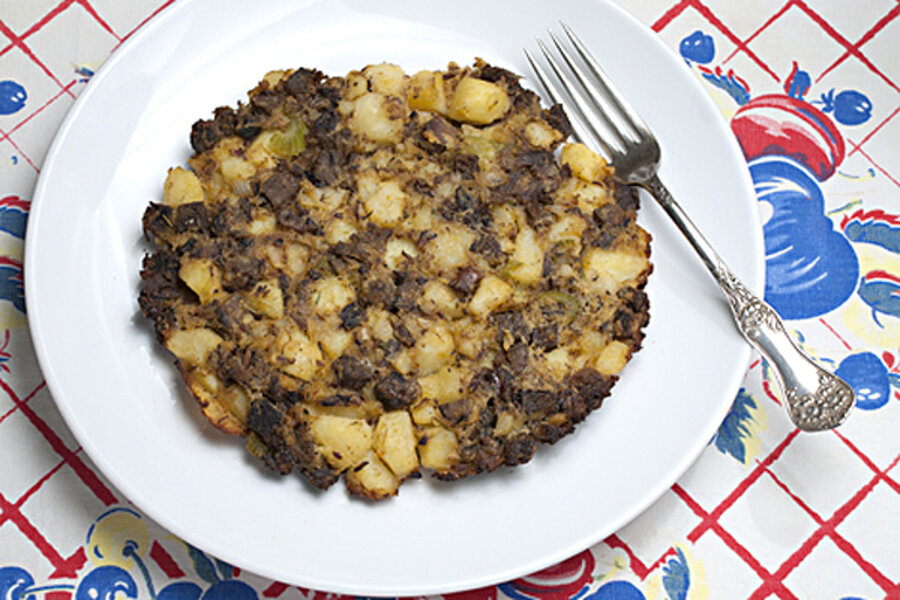Beef pot roast and potato hash
Loading...
Some foods are just made for each other. A grilled cheese sandwich and tomato soup; black beans and rice; apple pie and vanilla ice cream. And, of course, beef and potatoes.
These days we are not eating meat as often as we once did, trying to be more mindful of the way we live on the planet. But when we do, we still love it. And we don’t waste any of it.
The arrival in the mailbox of the annual Saveur 100 issue was the gateway to a new to me recipe that is an old American classic: hash. The Saveur 100 is always one of my favorite reading events – it’s a thrill when it arrives and a pleasure throughout the year. Saveur always talks about the coolest trends, the most amazing destinations, and of course the oh golly! examples of local favorites (“Ohio nachos”). I excavate it from our magazine mountain again and again throughout the year for inspiration or just to while away the time.
One item in this year’s 100 particularly hit a chord with me: prime rib hash from Keen’s Steakhouse in Manhattan.
I happened to make our version of this hash from basic, simple pot roast that happened to be left over from a recent wintry dinner. But this dish would be even more wonderful with out-and-out roast beef, cooled and then cubed. We took our leftover pot roast and sliced it into half-inch cubes, and that was the first step in this really rather easy to assemble dish.
Our version serves at least 4 people for a cozy weekend lunch or a comfy, casual evening of a dinner and a movie at home. Serve it with a leafy dark-green salad. For dessert, serve our gingerbread or cherry orange loaf cake, both of which you can make ahead. This hash also reheats well, good news for those of us who love tasty leftovers.
Beef pot roast and potato hash
Serves 4 generously
10 to 12 ounces leftover beef pot roast (or roast beef) cut into 1/2-inch cubes (see Kitchen Notes)
2-1/2 pounds of Yukon Gold potatoes (see Kitchen Notes)
6 tablespoons chopped shallots
2 stalks celery, finely sliced crosswise
2 or 3 tablespoons ketchup
2 or 3 tablespoons sriracha (see Kitchen Notes)
1 tablespoon fresh rosemary, chopped (see Kitchen Notes)
2 teaspoons salt
freshly ground black pepper
olive oil
butter (optional)
Special Equipment: Two 12-inch skillets ovenproof to 400 degrees F. This volume of ingredients makes two skillets worth of hash.
Peel the potatoes and cut into chunks about 1/2-inch to 3/4-inch in size. Put into a pot, cover with cool water, bring to a boil and simmer until tender. Immediately drain, rinsing with cold water. Put in a big bowl. Mash the potatoes briefly and gently – you want most of the cubes to be broken down, but a bit of “cubiness” to remain. Add the cooked beef to the bowl.
Preheat oven to 400 degrees F. In an oven-safe skillet, heat up 2 teaspoons olive oil over a medium flame. Add the shallots and celery and sauté for two minutes, until the shallots are clear and limp. Add this to the potato and beef mixture. Also add a good grating of black pepper, the salt, the fresh rosemary, ketchup, and sriracha. Mix everything together until it is pretty uniform.
To each of the two skillets, add 1 or 2 tablespoons olive oil and a teaspoon of butter (which is optional, but adds a nice buttery touch) and heat to medium low. In each skillet, put half the hash mixture and spread out so it is even and uniform. Press down all around with a sturdy spatula to encourage it to form a cake. Turn up the heat a bit to medium. Sauté until the bottom begins to turn golden, about 3 or 4 minutes. Transfer the pans to the oven and bake until the top begins to brown, about 10 minutes depending on your oven (see Kitchen Notes).
You may also prepare this as an individual serving. Cut the recipe in 1/4 and prepare in a small (10-inch) ovenproof skillet. This is a hearty eater serving – very generous. When the pan emerges from the oven, flip the hash onto the serving plate so that the well-browned bottom shows. Or you may cut the recipe in half to serve two or three people, cooking it in one skillet. If you fix this in big skillets, then serve wedges of the hash straight from the pan.
Kitchen notes
Choice (of) meats. I used leftover beef pot roast. You can use pretty much any simply prepared leftover meat or fowl – roast chicken, roast turkey or, of course, corned beef.
You say potato… I used Yukon Gold because that is what we had in the fridge. Russets would also work well.
Ketchup and sriracha. If you prefer no spiciness, then omit the sriracha and replace with the same amount ketchup. Alternatively, instead of sriracha, substitute oyster sauce. Also, once you have mixed everything together, if the mix seems dry or like it needs more punch, then add another tablespoon of either sauce.
Rosemary, fresh or dried. Yes, if you do not have fresh, you may use dry, but sauté it along with the scallion and celery. Also, use about half as much. Alternatively, substitute tarragon.
Oven time. Our rental apartment oven is so fickle that I never can be sure what kind of timing I may expect – the same gingerbread recipe, for instance, may take 28 minutes or 35 minutes. Thus my eternal reminders about oven dependability. Use an oven thermometer, if you have one, to check the temperature. Otherwise, just know your oven and/or start checking your food’s progress early and often.







